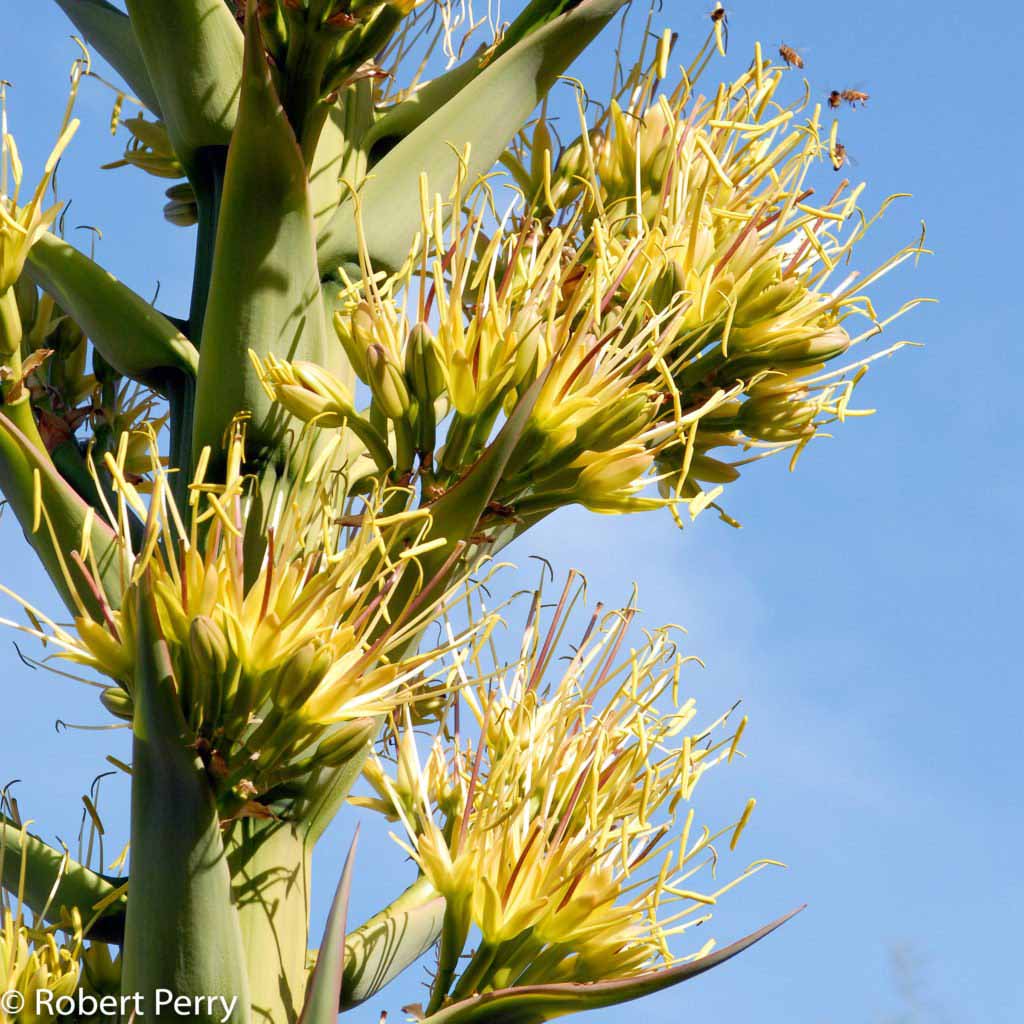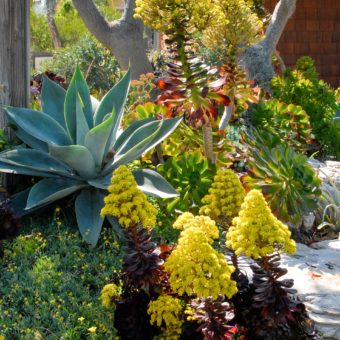Blue Glow agave is a recent introduction into the crowded field of agaves. It is a small growing hybrid between A. attenuata and A. ocahui that grows to 18-24 in. dia. with narrow and sharply pointed blue-green leaves with red margins. This is a monocarpic cultivar that grows in solitary rosettes, making it useful for containers, rock gardens and mass plantings. Care should be taken to place this plant where its sharp spines can be avoided. Early plantings indicate a tolerance of temperatures of at least 28°F.
Blue Glow agave
Agave ‘Blue Glow’
Description
Plant properties
Water needs
Maintenance
Commercial sites
Plant Type: Agave
Foliage Character: Evergreen
Habit: Uniform, Symmetrical, Solitary, Rigid, Compact
Growth Rate: Slow
Foliage Color: Blue green
Flower Color: Yellow
Flower Season: Insignificant
Soil Adaptations: Well-draining soil
Exposure Adaptations: Wind, Heat, Drought, Aridity, All day sun
Function: Container plant, Rock gardens, Raised planters, Hummingbird plant, Grouped, Foliage accent plant
Height: 18 in. – 20 in.
Width: 18 in. – 20 in.
Foliage Character: Evergreen
Habit: Uniform, Symmetrical, Solitary, Rigid, Compact
Growth Rate: Slow
Foliage Color: Blue green
Flower Color: Yellow
Flower Season: Insignificant
Soil Adaptations: Well-draining soil
Exposure Adaptations: Wind, Heat, Drought, Aridity, All day sun
Function: Container plant, Rock gardens, Raised planters, Hummingbird plant, Grouped, Foliage accent plant
Height: 18 in. – 20 in.
Width: 18 in. – 20 in.
Watering Schedule: Low 1
For most situations, we recommend watering deeply every 3-4 weeks after establishment.
Learn how to apply this watering schedule to your landscape on our How to water waterwise and California native plants page.
Important Notes
- These are general guidelines. Always observe and adjust as necessary for your landscape.
- If it rains over 1” you will likely not need to water for at least another 3-4 weeks. Before watering again, check the soil. It should be significantly dry at least 4” below the soil surface before watering.
- If you have a “smart timer” or weather sensitive irrigation controller, it is best not to use the automatic weather adjusting features for plants in this category. While very useful for watering higher water demanding plants, those in this category have natural drought adaptations which mean they do not need to be watered more in warm weather. Using the weather adjusting features will result in either overwatering in summer or underwatering in fall and spring.
- It is important to group plants with the same water needs together in the landscape to avoid needing to over or under water plants when running your irrigation system.
Many agave species and cultivars tend to grow “pups.” These are small new plants that grow off of the “mother” plant and are attached underground. Pups are often directly at the base of the mother plant, but can also grow some distance away, depending on the species of agave. These pups can be removed with a shovel at any time to preserve the appearance of the mother plant and to prevent overcrowding. Pups can often be either planted elsewhere in the garden, or rooted into pots for later planting or to give to someone else.
Agaves are “monocarpic,” which means that after years of growing, they only flower one time, and then the main plant dies. Often pups remain, providing new plants to replant in the same place if desired. The length of time from planting an agave until it flowers varies and is related to multiple factors including growing conditions and plant species.
Over time, some of the lower leaves of agaves naturally die and dry out as new leaves grow. This is normal, and dry leaves can be carefully pulled off or cut with a small sharp saw or serrated blade. Be careful not to remove too many leaves, or you might lose the beautiful natural form of the agave and end up with something looking more like a pineapple!
The most important factor in keeping agaves as a low maintenance plant is to understand how large mature agaves of each species and cultivars will be (listed above), and provide for that much growing space in planting plans. Often people plant agaves which at maturity will be far too large for the space they are put in, but look nice when they are newly planted and young. If they do not have enough space to grow, many agaves become hazardous near paths and sidewalks when their spines reach into places people are walking. This leads to them having to be cut back on a regular basis, creating an ugly plant that is no longer low maintenance and is hazardous. Do things right: plant in the right place with enough space and enjoy a beautiful low-maintenance plant!
References
Sign Up For Free
To access all the features of this website, please create an account with us. Privileges include:
- Ability to print plant groups, lists and plant profiles
- Create your own plant groups
- Receive monthly updates by email
An online resource for you to learn about and choose the best plants for your inland Southern California landscape.
Promoting water conservation through education, stormwater capture, waterwise landscapes, and other initiatives.
We provide programs, services, and resources to serve audiences of all ages to cultivate a community-wide conservation ethic and build regional capacity for water resilience.









